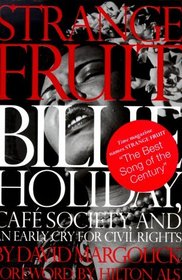Another edition of Margolick's book has a more brief and accurate subtitle: Biography of a Song. This concise book covers the creation, performance, reception, and myth of the song most closely associated with Lady Day. Margolick asserts that while 'Strange Fruit' has slipped through the cracks of academic study because it defies easy categorization (folk? jazz? protest song?), it has never slipped through the consciousness of those who've heard it.
Margolick contextualizes the composer, singer, song and audiences in well-researched and non-scholarly prose. Billie Holiday first sang 'Strange Fruit' in 1939, the same year that 'Gone With the Wind' thrilled audiences and Hitler marched into Poland. Contemporary reactions and responses to the song are fascinating. Everyone experienced discomfort while some disdained its 'lack of melody'. The depressing and upsetting lyrics kept it off the radio and the expensive, not widely distributed release by Commodore Records meant that large parts of the U.S. didn't hear the song. Though 'Strange Fruit' was powerfully resonant for black intelligentsia and earnestly progressive Northern whites, the black press wrote little about troubled Holiday or the song. Some black people didn't care for the song at all because it represented victimhood.
People's remembrances of hearing the song--live or recorded--were scattered throughout the text, as were other performers' thoughts and feelings about giving voice to the raw and excruciating song that Billie made her own. This is a short and fascinating read
Margolick contextualizes the composer, singer, song and audiences in well-researched and non-scholarly prose. Billie Holiday first sang 'Strange Fruit' in 1939, the same year that 'Gone With the Wind' thrilled audiences and Hitler marched into Poland. Contemporary reactions and responses to the song are fascinating. Everyone experienced discomfort while some disdained its 'lack of melody'. The depressing and upsetting lyrics kept it off the radio and the expensive, not widely distributed release by Commodore Records meant that large parts of the U.S. didn't hear the song. Though 'Strange Fruit' was powerfully resonant for black intelligentsia and earnestly progressive Northern whites, the black press wrote little about troubled Holiday or the song. Some black people didn't care for the song at all because it represented victimhood.
People's remembrances of hearing the song--live or recorded--were scattered throughout the text, as were other performers' thoughts and feelings about giving voice to the raw and excruciating song that Billie made her own. This is a short and fascinating read




